Kigelia font family
Overview
Kigelia is a large typeface family that contains the most prominent writing systems in Africa. Kigelia’s characters have a warm, open, sans serif style, with hardly any contrast between thick strokes and thin strokes in the Light weight, a little contrast in the Regular weight, and quite strong contrast in the Bold weight, in each script.
Type designers Mark Jamra and Neil Patel designed Kigelia, with consultation and critiques from a wide variety of language experts and native speakers. The Kigelia font has three weights, Light, Regular, and Bold. It has capitals and lowercase letters for the Latin, Greek, and Cyrillic alphabets, including the International Phonetic Alphabet and the African Reference Alphabet, as well as the characters needed to typeset the N’ko, Adlam, Vai, Ge’ez, Tifinagh, and Osmanya scripts. Only the scripts that have a tradition of an alternate cursive style are included in the complementary italic fonts. Kigelia Arabic is added to the family as a companion font family to support African languages written with Arabic script.
| Description | |
|---|---|
| File name | kigeliaarabic-light.ttf kigeliaarabic-regular.ttf kigelia-bold.ttf kigelia-bolditalic.ttf kigelia-italic.ttf kigelia-light.ttf kigelia-lightitalic.ttf kigelia-regular.ttf |
| Styles & Weights | Kigelia Arabic Bold Kigelia Arabic Light Kigelia Arabic Regular Kigelia Bold Kigelia Bold Italic Kigelia Italic Kigelia Light Kigelia Light Italic Kigelia Regular |
| Designers | Mark Jamra and Neil Patel |
| Copyright | © 2018 by Jamra Patel LLC. All rights reserved. |
| Font vendor | Jamra Patel |
| Script Tags | dlng:'Adlm', 'Arab', 'Ethi', 'Nkoo', 'Osma', 'Tfng', 'Vaii' slng:'Adlm', 'Arab', 'Cyrl', 'Grek', 'Ethi', 'Latn', 'Nkoo', 'Osma', 'Tfng', 'Vaii' |
| Code pages | 1252 Latin 1 1250 Latin 2: Eastern Europe 1251 Cyrillic 1253 Greek 1254 Turkish 1256 Arabic 1257 Windows Baltic Mac Roman Macintosh Character Set (US Roman) |
| Fixed pitch | False |
Licensing and redistribution info
- Font redistribution FAQ for Windows
Products that supply this font
This typeface is available within Office applications. For more information visit this page.
Style & weight examples
Kigelia Adlam
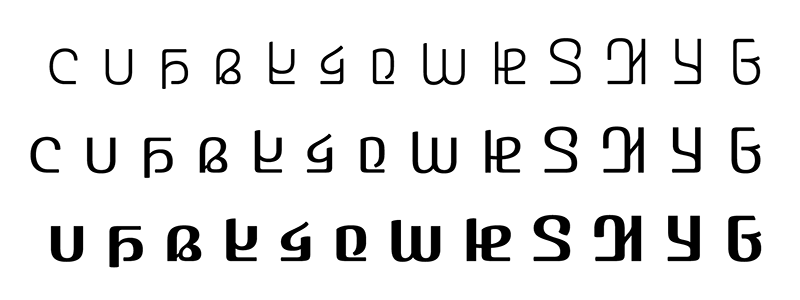 The Adlam alphabet was invented in Guinea in the 1980s by Abdoulaye Barry and Ibrahima Barry for the Pular (Fulfulde) language spoken by the Fulani people of West Africa. Adlam reads right-to-left and has upper- and lowercase letters in two variants: connected and unconnected. The designers received feedback from Abdoulaye and Ibrahima Barry throughout the design of this complement.
The Adlam alphabet was invented in Guinea in the 1980s by Abdoulaye Barry and Ibrahima Barry for the Pular (Fulfulde) language spoken by the Fulani people of West Africa. Adlam reads right-to-left and has upper- and lowercase letters in two variants: connected and unconnected. The designers received feedback from Abdoulaye and Ibrahima Barry throughout the design of this complement.
Kigelia Arabic
 Kigelia Arabic contains a Modern Standard Arabic complement as well as African Ajami characters and many typical African ligatures. Kigelia Arabic supports various African languages written using the Arabic script, including Moroccan Darija, Algerian Darja, Tunisian Arabic, Chadian Arabic, Hausa, Wolof, Soninke, Swahili, Manding, Tuareg, Tachelhit-Shilha, Mogofin, Susu, Fulfulde, and Bravanese. The designers received advice and feedback from Fallou Ngom, Lamine Diallo, Jesus Maclean, Kifah Abdulla, Kourosh Beigpour, Dmitry Bondarev, Coleman Donaldson, Djibril Dramé, Darya Ogorodnikova, and Mamoun Sakkal.
Kigelia Arabic contains a Modern Standard Arabic complement as well as African Ajami characters and many typical African ligatures. Kigelia Arabic supports various African languages written using the Arabic script, including Moroccan Darija, Algerian Darja, Tunisian Arabic, Chadian Arabic, Hausa, Wolof, Soninke, Swahili, Manding, Tuareg, Tachelhit-Shilha, Mogofin, Susu, Fulfulde, and Bravanese. The designers received advice and feedback from Fallou Ngom, Lamine Diallo, Jesus Maclean, Kifah Abdulla, Kourosh Beigpour, Dmitry Bondarev, Coleman Donaldson, Djibril Dramé, Darya Ogorodnikova, and Mamoun Sakkal.
Kigelia Ge’ez
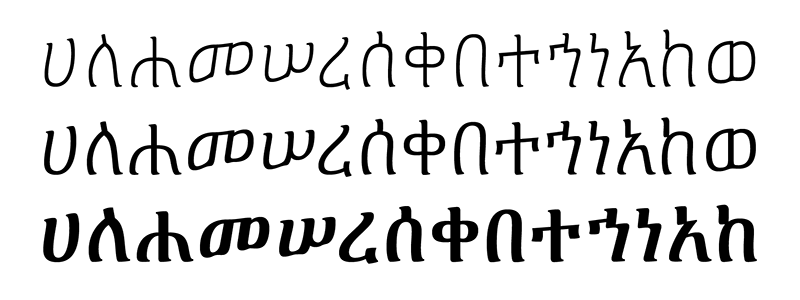 Kigelia has a full complement of the Ge’ez alphasyllabary, which serves the languages Amharic, Tigrinya, Tigre, Harari, Gurage, Sebatbeit, Gamo-Gofa-Dawro, Basketo, and Gumuz. The designers received feedback from Daniel Yacob and John Hudson.
Kigelia has a full complement of the Ge’ez alphasyllabary, which serves the languages Amharic, Tigrinya, Tigre, Harari, Gurage, Sebatbeit, Gamo-Gofa-Dawro, Basketo, and Gumuz. The designers received feedback from Daniel Yacob and John Hudson.
Kigelia Latin, Greek and Cyrillic
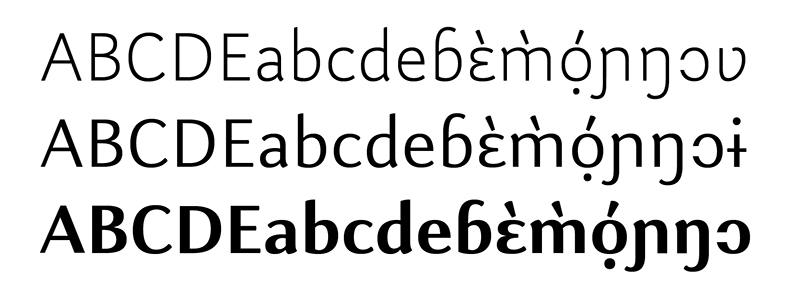 Kigelia contains full complements of the International Phonetics Alphabet, the African Reference Alphabet, additional characters for African languages, some localized variants, “old-style” figures, set fractions, numerators, denominators, superiors, and scientific inferiors. There are also Standard Greek and Standard Cyrillic complements. For this part of Kigelia, the designers received consultation from Denis Jacquerye, Donald Osborn, Gerry Leonidas, and Ksenya Samarskaya.
Kigelia contains full complements of the International Phonetics Alphabet, the African Reference Alphabet, additional characters for African languages, some localized variants, “old-style” figures, set fractions, numerators, denominators, superiors, and scientific inferiors. There are also Standard Greek and Standard Cyrillic complements. For this part of Kigelia, the designers received consultation from Denis Jacquerye, Donald Osborn, Gerry Leonidas, and Ksenya Samarskaya.
Kigelia N’ko
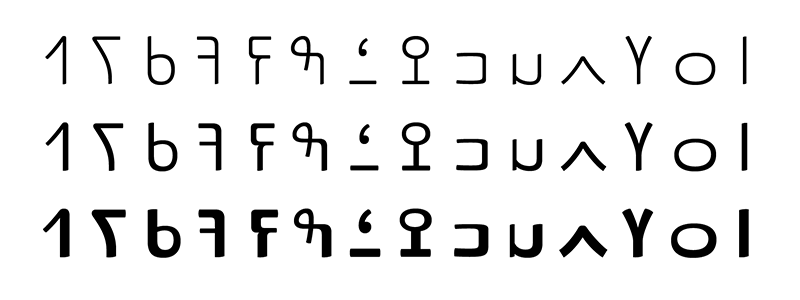 The N’ko alphabet was invented in 1949 in Guinea by Soulemana Kantè for the Manding language in the regional languages Maninka, Dioula, Bambara, and Mandinka. The designers received guidance on this script from Prof. Mamadi Diané, Boubacar Diakité and Solo Farabado Cissé.
The N’ko alphabet was invented in 1949 in Guinea by Soulemana Kantè for the Manding language in the regional languages Maninka, Dioula, Bambara, and Mandinka. The designers received guidance on this script from Prof. Mamadi Diané, Boubacar Diakité and Solo Farabado Cissé.
Kigelia Osmanya
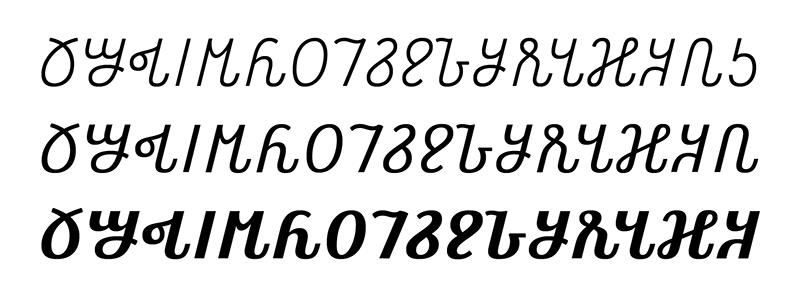 Osmanya is a writing system invented between 1920 and 1922 by Osman Yusuf Kenadid to transcribe the Somali language. Kigelia's Osmanya complement is valuable for digitizing and preserving historical and cultural documents.
Osmanya is a writing system invented between 1920 and 1922 by Osman Yusuf Kenadid to transcribe the Somali language. Kigelia's Osmanya complement is valuable for digitizing and preserving historical and cultural documents.
Kigelia Tifinagh
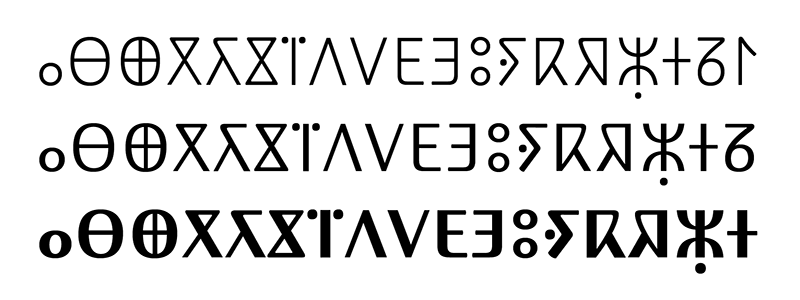 Kigelia’s Tifinagh complement contains all of the characters and code needed for the North African languages and regional languages that use this ancient script. Stylistic sets are included which provide the user with access to all of the documented regional orthographic variants. The careful design of the Tifinagh glyphs and extensive kerning make this design an excellent choice for extensive texts.
Kigelia’s Tifinagh complement contains all of the characters and code needed for the North African languages and regional languages that use this ancient script. Stylistic sets are included which provide the user with access to all of the documented regional orthographic variants. The careful design of the Tifinagh glyphs and extensive kerning make this design an excellent choice for extensive texts.
Kigelia Vai
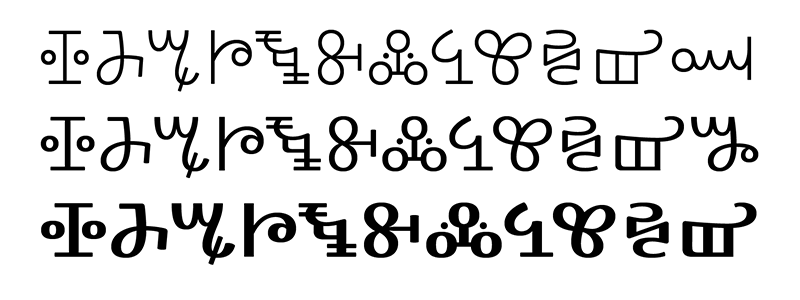 Kigelia’s Vai complement contains all the glyphs needed by the Vai language community in Liberia and Sierra Leone. The Vai syllabary was invented in 1833 by Mɔmɔlu Duwalu Bukɛlɛ and this design preserves the liveliness and humanity of the original script. The designers received feedback on this script from Tombekai Sherman and Charles Riley.
Kigelia’s Vai complement contains all the glyphs needed by the Vai language community in Liberia and Sierra Leone. The Vai syllabary was invented in 1833 by Mɔmɔlu Duwalu Bukɛlɛ and this design preserves the liveliness and humanity of the original script. The designers received feedback on this script from Tombekai Sherman and Charles Riley.